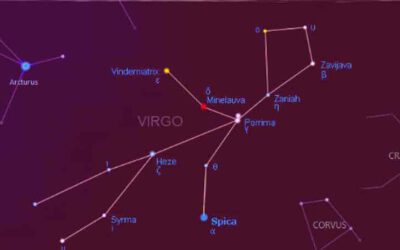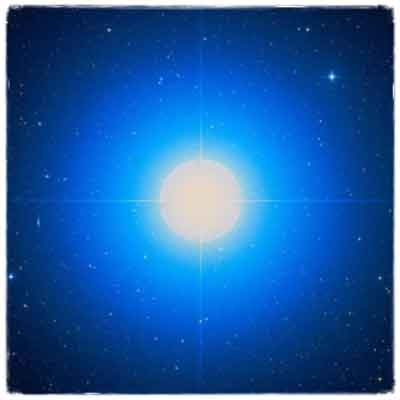
The #star of #Chittra #Nakshatra is called #Spica. This is the brightest star in the constellation of #Virgo. The stars of Virgo form the reclining figure of a woman, with Spica as the left hand of the Virgin – this yoga practice deriving from the left hand path of Tantra.
Spica is most visible in the sky in the northern hemisphere, in the months March to July. The Spica star can be seen well in the triangle formed by the 3 bright stars of Arcturus, Spica and Regulus. The base of the triangle is made by Spica and Regulus.
Virgo is the biggest constellation in the zodiac. It is most visible after sunset in the month of May. As the largest zodiac constellation the Sun takes 44 days to pass through it, longer than for any other constellation. The constellation of Virgo is also notable as it has 20 stars with known planets, which is more than any other constellation.
The long transition of the sun through the Virgo constellation gives the jewel of the Spica star an extended period to harness the solar force. Chittra is an active Nakshatra of radiance, many thousands of times brighter than the sun.
#Mangala (planet #Mars) is the ruling planet of Chittra. Mars rules the solar-plexus Chakra as the active expression of its energy.
The Manipura chakra, as the solar-plexus is called, translates as the Jewel in the City. This is the fire in the belly that inclines us to action. The red planet of Mars is the fire of action that flows in the blood. The desire and impulse of action is put into creative use by the force of Chittra. Chittra is the second of the Mars ruled Nakshatras. All the Mars ruled Nakshatras deal with the skill of transforming and refining the elements of life.
How we use
and channel our life force
is the initiation
of the Mars ruled Nakshatras.
#Mrgasirsa is the first Mars ruled Nakshatra that gives the initiation of cultivation and gathering Shakti. Chittra comes next and gives the initiation of shaping the Jewel of life with the Shakti we have preserved through the first initiation. The final Mars ruled Nakshatra is #Dhanishta, which teaches us the further lesson of caring for the radiance of the jewel by honouring the law of rhythms.
These Nakshatra’s are dealt with in more detail in past blogs entries, which you may refer to here.
http://healinginthewillows.com/mrgasirsa/
http://healinginthewillows.com/dhanishta-nakshatra/
We can start to see how #Nakshatras fit together when we consider them as a group under their planetary rulership, in this case Mars. By considering them as a group, we may get a deeper insight into the lessons they present to us.
Chittra Nakshatra travels between Kanya (Virgo) and Tula (Libra) and brings the creative earthly juices of the Virgin to an awareness of the opposites. The balance of force is revealed by Tula, which means to weigh. When we consider our life force carefully, we become aware of the options we have. Creation is a process of weighing things up and applying the weight of our life force with consideration.
The creativity
that Chittra Nakshatra teaches us
is one of consideration,
calculation and implementation
of our energies.
Chittra is the careful cutting and shaping of the facets of the jewel. This is a detailed use of creative force, that has power in considering the formations and outcomes of applied life force.
We see that Chittra is oftentimes symbolised by a pearl in an oyster. Like the delicate work of faceting a jewel, the creation of the pearl is a slow and gradual process. It is the intelligent and sober application of force. Chittra brings us the awareness of the jewel of our life-force. It is the pearl of great price. Carefully looking at where we cast our pearls is the teaching that the rays of this Star shines upon us here on earth.
The Virgin in the Cave
The Tale of Persephone
We see that the Ancient Greeks put the celestial codes of the constellation of Virgo into the story of Persephone. Persephone was a beautiful Virgin. Her light spring-like nature was the opposite of the underworld god, known by the name of Hades.
Hades fell in love with Persephone and, one day, while Persephone was gaily picking flowers in a lush meadow he left his dark underworld kingdom and came to the earth to abduct her.
The earth became barren until Persephone found release from his cavernous clutches. But Persephone was bound to return to the underworld, upon account of a trick played on her by Hades.
Her return to earth corresponds to the months of abundance, when the Constellation of Virgo is most visible in the night sky. The season of spring occurs when the constellation of Virgo appears in the early evening above the horizon. When she’s no longer there, it is winter. That is when Persephone returns to the underworld. From the Northern Hemispheres perspective, Virgos absence from the evening sky is found in late autumn, winter and early spring. Virgo’s reappearance in the sky at nightfall comes again with the rising season of spring.
The Celestial Architect
The Polarities of Creation
The God of Chittra Nakshatra is #Tvashta. He is the #celestial #Architect who transfers his inspiration and energy to us through his star Chittra.
Tvashta seems a bit multi-faceted himself. He appears complex at first glance. Tvashta has a dual form. One facet of Tvashta is Vishwakarma, who is the architect of the Devas.
We see, interestingly, that in regions of South India the crafters are known as the Vishwakarmas. The other facet of Tvashta, is Mayasur, who is the architect of the Asuras.
Both these faces of Tvashta deal with his skill in design, architecture, and crafting with creative force. As Vishwakarma, Tvashta creates forms that are diaphanous and creative. And as Mayasur he creates destructive forms coated in glamour and trickery. Tvashta, it can be seen, is the force and skill of the creative energy.
How is the creative force is wielded in our hands? As the life-force is released from the grip of unconsciousness, the range of possibility of creative force is liberated from limitation. The Tantric is a creative voyager who releases the skills of Tvashta by attempting to awaken from unconscious dreams.
One other noteworthy thing about Tvashta, is that he is one of the 12 Aditya’s. These are the deities that are assigned to each calendar month. The Aditya’s transport and give the teaching of the particular month that they rule over.
All the Aditya’s hold lotus flowers.
What is unique about Tvashta, is that his lotus flower, is the only one amongst the Aditya’s that is closed. This is a worthy symbol of meditation that reveals many meanings when pondered upon. Perhaps we might rather simply say that creativity requires a stage of introverting to gather force, before it is put to action. We see this principle at play in the creation of life in the womb.
When the introverted gathering of elixir is not honoured, then real creative force might very well de deficient. Creativity without elixir, might then come to be replaced by a predictable and creatively dead clock-work engine. When night falls, not only does a lotus close its petals, but it enters back into the waters from whence it came.
The stone and the Jewel
Channelling the Life-Force
Chittra Nakshatra is the star that brings us the teaching and blessing of channelling our life energies towards the creation of beauty. Someone who works with cutting and polishing diamonds is called a diamantaire. The skill of a diamantaire, encapsulates very much the quality that Chittra Nakshatra presents to us.
To become a diamantaire, requires long years of study into the science and art that is diamond polishing. Painstaking attention to detail and patience is required. The fine work of cutting and polishing is preceded by separating the diamond from the ore. Many hours are required to cut a diamond.
A diamond
can only be cut
by another diamond.
This fact is something worth pondering on, when considering the creative work of polishing the diamond of our lives. The diamantaire takes the rough diamond stone and with the magic of an alchemist, transforms of to a sparkling and mesmerising jewel.
Life energy can be used to launch a stone and create injury and destruction. But, the very same life force, can be channelled into the detailed work of artfully shaping the facets of a stone, and creating a jewel.
By the focus of our life energies, we can take a stone that was once a rough sharp object – perhaps able to cut the hand, and not particularly alluring – and shape it into a jewel of fascination and reflective beauty.
The word Chittra means radiant, shining, delicately-detailed, multi-layered, multi-faceted and lustrous. It is most appropriate that this star is symbolised by a Jewel.
Chittra also contains the word Chit, which means ‘pure awareness’ and could be seen as referring to the shining jewel of the soul. Chit is suffixed by Tra, in the name of this Nakshatra. Tra is derived from the Sanskrit word Tryate, and means to set free. So Chittra in this sense, translates as ‘the setting free of the jewel of pure awareness’.
A work of art, such as a painting, is referred to as Citr in Hindi. This is derived from the word Chittra. Again, this points to the principle of this star, to bring us the illumination to shape the jewel of our life. Chittra for this reason has come to be known as the star of carving the jewel.
What is the condition of our jewel? Is it in the workshop, with us sitting attentively at the desk? Or, has it fallen to the wayside, as we nurture concerns, other than the jewel of our life?
Chinnamasta
Pure Life-Force
Chinnamasta is the pure ruby red life force. She is the multifaceted jewel, that tells us of the possibilities of movements within the constellation of life. She shows us the options we have, of how to apply the life-force that we carry. She is the Vidya (wisdom) that meets us at the ‘tripple-crossroads’ of power.
In every movement of desire, we play either a passive or an active seat.
Chinnamasta is the seat between the two familiar ways. She is the teacher of transmitting and transmuting our life-force into sacred and spiritually potent action. Her jewel shines with the secret lustre of the union of two forces. Her Jewel is the meeting of polarities, and transmits the wisdom of sacred equilibrium. Her Jewel is the place where opposites and opposition are magically fused together.
When we hear the word equilibrium we might be prone to think of peace and wellbeing. But the equilibrium that Chinnamasta transports to us is a double sided balance and integrity, between the forces of rapturous chaos and poised awareness. She tears her head from her body, but she drinks of the middle stream of equilibrium force, without spilling a single drop from of the jewel coloured elixir of her life blood.
https://healinginthewillows.com/chittra-nakshatra/


